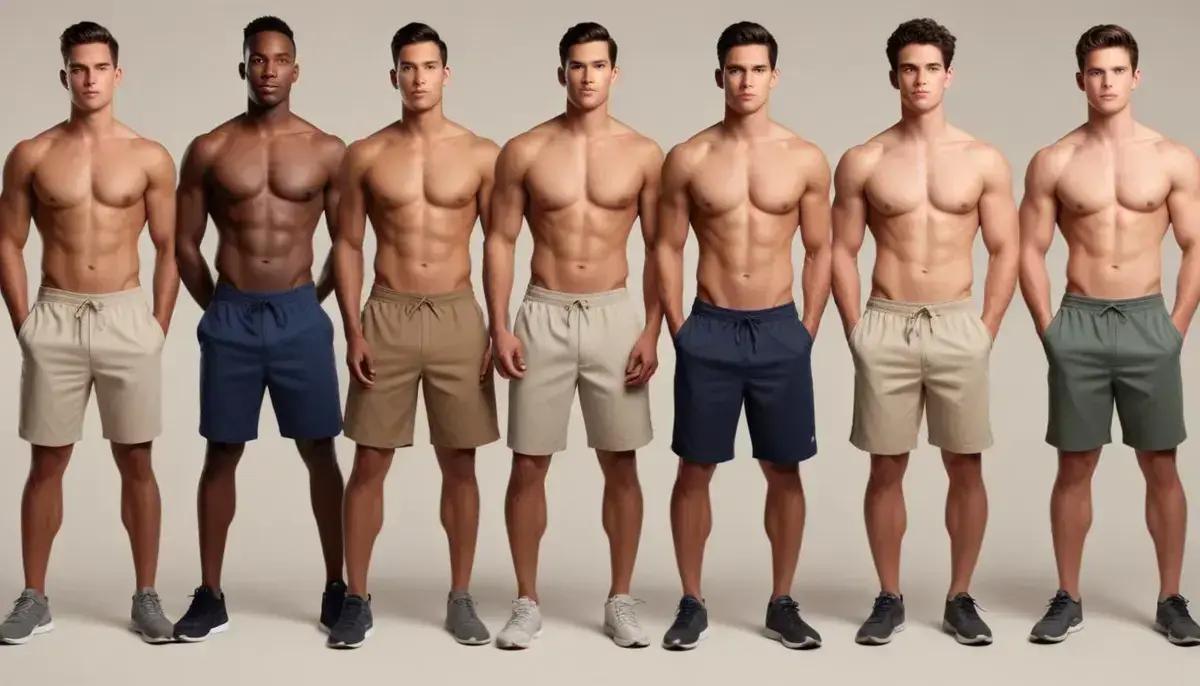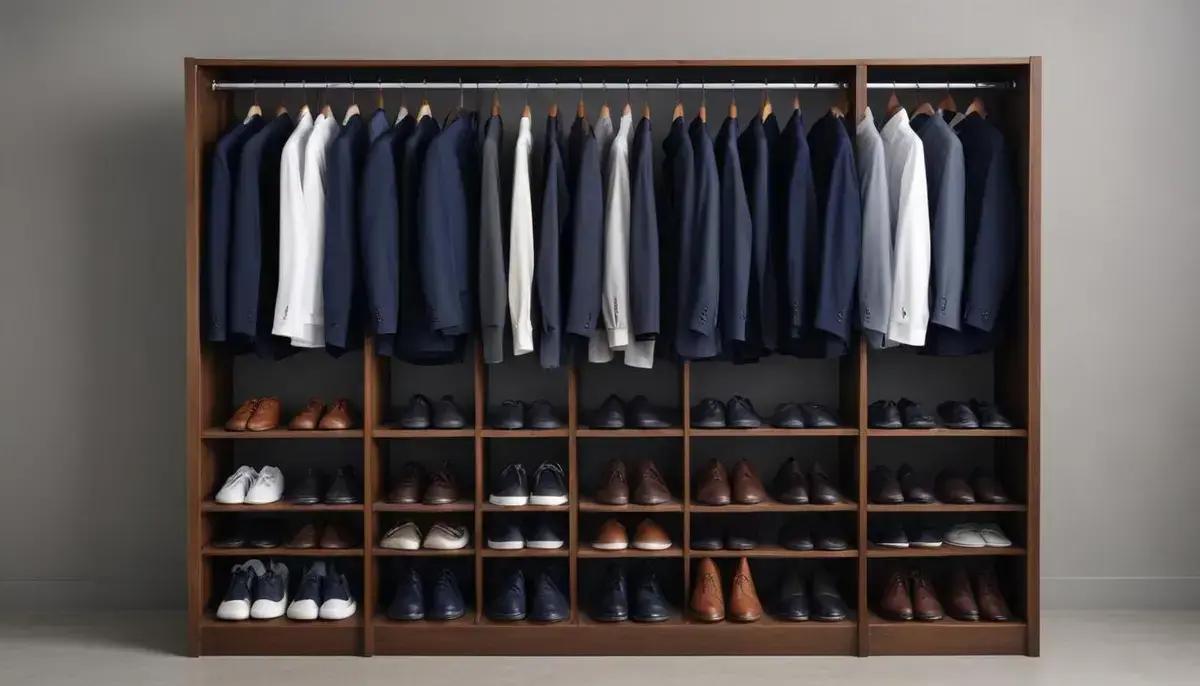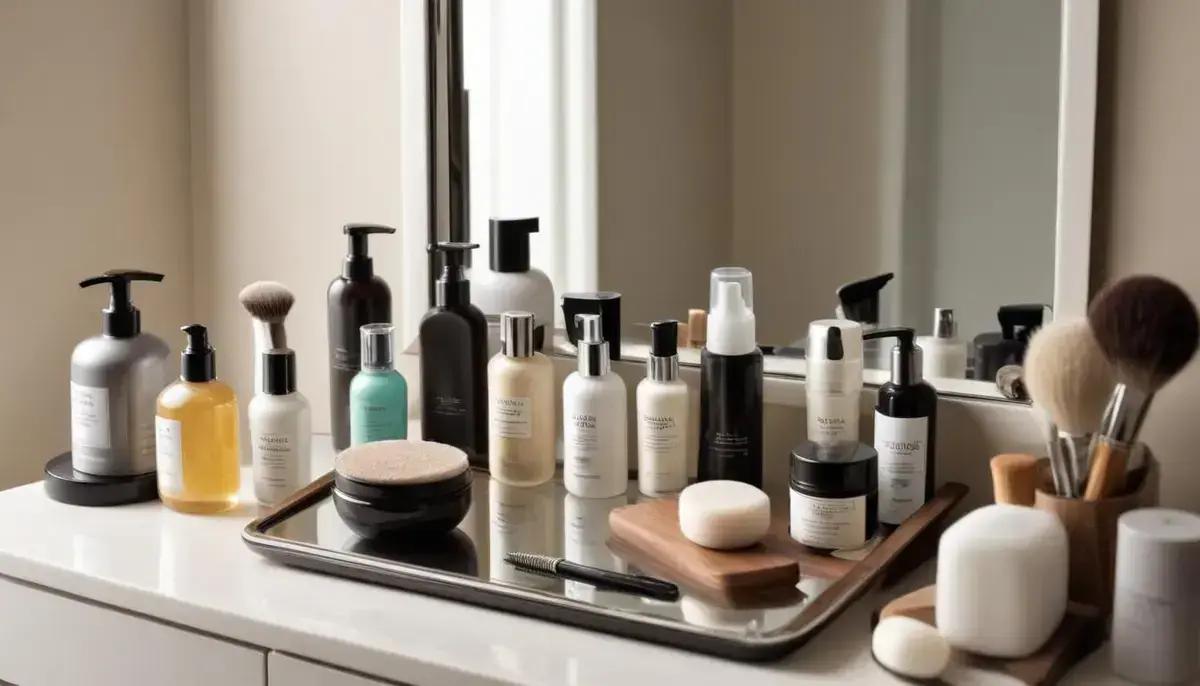Men’s style doesn’t have to be complicated or expensive to make a powerful impact. With 2025 bringing fresh fashion perspectives, you can easily elevate your look using practical techniques that work for real life. Ready to discover which trends deserve space in your closet?
Essential wardrobe pieces every modern man needs
Every modern man’s wardrobe should start with versatile basics that can be mixed and matched for any occasion. A well-fitted navy or charcoal suit is non-negotiable for formal events, while dark denim jeans in a straight cut work for both casual and smart-casual looks.
Shirts That Cover All Bases
Invest in three core shirts: a crisp white dress shirt for formal wear, a light blue oxford for business casual, and a quality polo for relaxed weekends. These alone can create over a dozen outfit combinations when paired properly with your other essentials.
The Outerwear Trinity
Three jackets every man needs: a tailored wool overcoat for winter, a lightweight bomber for transitional weather, and a classic denim jacket for casual layers. These pieces will see you through all seasons while instantly elevating your style.
Don’t underestimate the power of quality footwear – one pair of black leather dress shoes, brown brogues, and clean white sneakers will handle 90% of your needs. Rotate between these to extend their lifespan and always keep them well-maintained.
Accessories That Matter
A slim leather belt in black and brown, a versatile watch with interchangeable straps, and at least two neutral-colored ties (one solid, one patterned) complete your essential accessories. These small details make a big difference in pulling outfits together.
Remember, building a functional wardrobe isn’t about quantity – it’s about strategic selection. Each new piece should work with at least three items you already own. This approach saves money, reduces decision fatigue, and ensures you always look put-together.
Color coordination techniques that actually work
Mastering color coordination starts with understanding the color wheel. Complementary colors (opposites on the wheel) create bold contrasts, while analogous colors (next to each other) offer harmonious looks. For beginners, sticking to 2-3 colors per outfit prevents overwhelming combinations.
The Neutral Foundation
Build your outfit on neutral bases like navy, gray, black, or beige. These versatile backdrops allow you to experiment with accent colors in shirts, ties, or accessories without clashing. A gray suit with a burgundy tie demonstrates this perfect balance.
Seasonal Color Palettes
Different seasons call for different color approaches: earthy tones work well in fall, pastels shine in spring, bright colors pop in summer, and deep jewel tones excel in winter. This doesn’t mean strict rules – a winter navy blazer with summer white pants creates year-round sophistication.
Pay attention to color temperature. Cool-toned men (pinkish skin) look best in blues and grays, while warm-toned (yellowish skin) shine in browns and greens. Test colors against your wrist in natural light to see what complements your complexion.
Pattern Mixing Done Right
When combining patterns, vary their scale and maintain one common color. A fine-striped shirt pairs well with a larger-checked jacket if they share at least one matching hue. Always separate busy patterns with solid-colored ties or pocket squares.
Remember the 60-30-10 rule: 60% dominant color (like pants), 30% secondary (jacket), and 10% accent (tie/pocket square). This professional formula works for both business and casual wear, creating balanced, polished looks effortlessly.
How to choose the perfect fit for your body type

Finding clothes with the perfect fit begins with understanding your body type. The five main categories are rectangle, triangle, inverted triangle, oval, and trapezoid. Each has specific tailoring needs – for example, triangle shapes (wider hips) should balance proportions with structured shoulders.
Shoulder Fit Fundamentals
The shoulder seam should hit exactly where your shoulder bone ends. Too far out creates a sloppy look, while too far in restricts movement. For jackets, you should be able to comfortably slide one finger between the shoulder padding and your body when buttoned.
Pant Length Rules
Dress pants should break slightly at the shoe – one gentle fold in front. Slimmer builds can opt for no break, while athletic thighs need a slight taper below the knee. Avoid pooling fabric at the ankles, which makes legs appear shorter.
Shirt Sleeve Magic
Proper sleeve length shows 1/4 to 1/2 inch of shirt cuff under a jacket sleeve. For casual wear, sleeves should end at the wrist bone when arms are relaxed. Athletic builds often need tailored bicep areas to prevent tightness while maintaining clean lines.
Tailoring Tricks for Every Body
Shorter men should opt for higher armholes and slimmer lapels to elongate the torso. Taller frames benefit from extended jacket lengths and slightly wider ties. For oval shapes, structured fabrics and vertical patterns create flattering definition.
Remember the two-finger rule: You should be able to comfortably fit two fingers between your neck and shirt collar, and between your waist and belt. These simple checks ensure comfort while maintaining a polished appearance.
Seasonal fashion trends to watch in 2025
2025 brings exciting seasonal trends that blend retro influences with futuristic elements. For spring, expect to see soft pastel suits with deconstructed shoulders, while summer introduces technical fabrics in bold citrus hues – think lemon yellows and lime greens that pop against tanned skin.
Fall’s Textural Revolution
Autumn 2025 focuses on rich textures: corduroy returns in wide-wale variations, shearling accents appear on leather jackets, and wool blends get unexpected glossy finishes. Earth tones evolve with new mushroom beiges and deep merlot reds replacing traditional browns.
Winter’s Layered Approach
This winter celebrates intelligent layering – quilted vest under tailored coats, turtlenecks beneath unbuttoned dress shirts. Look for heat-reactive fabrics that change color in cold weather and reversible outerwear offering two distinct looks in one garment.
Year-Round Staples With a Twist
Several trends transcend seasons: relaxed-fit tailoring replaces skin-tight suits, sneaker-dress shoe hybrids gain popularity, and jewelry becomes more prominent with chunky signet rings and layered neck chains. These versatile pieces work across your entire wardrobe.
Pay attention to sustainable innovations like algae-based dyes and self-repairing fabrics that will dominate 2025 collections. Many brands are introducing capsule lines where each piece can be worn at least three different ways – a smart approach to conscious consumption without sacrificing style.
Accessorizing without going overboard
The art of balanced accessorizing follows the ‘one statement piece’ rule – choose one focal accessory and let others play supporting roles. A bold watch pairs well with simple leather bands, while patterned pocket squares demand understated ties. This approach creates interest without visual chaos.
The Three-Piece Limit
For most occasions, limit visible accessories to three key items: watch + bracelet + ring, or tie clip + cufflinks + pocket square. Business casual allows slightly more flexibility, but still maintain clear focal points. Too many competing elements dilute your overall look.
Material Mixing Techniques
Combine no more than two material types in your accessories – leather with metal, or fabric with wood. Avoid matching everything perfectly; a brushed metal watch looks more intentional with polished belt hardware than an exact match. Texture variation adds depth.
Seasonal Accessory Rotation
Heavier materials like thick leather and metals work best in fall/winter, while summer favors lightweight fabrics, woven bracelets, and lighter-colored accents. Rotating pieces seasonally keeps your look fresh and appropriate for the weather.
Remember proportion rules: bulkier frames need thicker watch cases, while slender wrists suit delicate chains. Your accessories should complement your body type just like clothing. When in doubt, remove one item before leaving – subtlety often makes the stronger statement.
Building a capsule wardrobe on any budget

Creating a capsule wardrobe starts with identifying your 10-12 most-worn pieces that mix and match effortlessly. Focus on quality basics in neutral colors that can be dressed up or down. A dark navy blazer, for instance, works for both office meetings and date nights when paired differently.
The Budget-Friendly Foundation
Invest 60% of your budget in three core items: a well-fitting pair of dark jeans, a versatile blazer, and quality leather shoes. These anchor pieces will last years with proper care. For the remaining 40%, look for sales on mid-range brands that offer good value.
Smart Shopping Strategies
Shop off-season for major savings – buy winter coats in spring and linen shirts in fall. Consider second-hand options for high-end pieces, focusing on items that show minimal wear like blazers and leather goods. Many barely-used designer items can be found at 70% off retail prices.
Care Over Consumption
Proper maintenance extends clothing life exponentially. Learn basic repairs like replacing buttons and fixing loose hems. Rotate shoes to let them rest between wears, and use wooden hangers for jackets to maintain shape. These small habits make budget pieces last like premium items.
Remember the cost-per-wear principle: A $200 jacket worn 100 times costs $2 per use, while a $50 jacket worn 5 times costs $10. Sometimes spending more upfront saves money long-term. Build your capsule gradually, adding only pieces you’ll wear weekly.
Professional vs casual style transitions
Mastering the professional to casual transition requires strategic layering and smart accessory swaps. Start with a professional base – a well-tailored blazer and dress pants – then remove or replace elements to casualize your look. The key is maintaining polish while dialing down formality.
The 5-Piece Transformation
With just five items (blazer, dress shirt, jeans, sneakers, and a casual watch), you can create both boardroom and weekend looks. Swap dress shoes for clean white sneakers, replace the tie with an open collar, and exchange dress pants for dark denim to instantly casualize your outfit.
Fabric Choices Matter
Certain fabrics transition better between settings. Unstructured cotton blazers work for both office and dinner, while technical wool blends resist wrinkles for all-day wear. For shirts, opt for twill or oxford cloth over traditional dress shirt fabrics for easier styling versatility.
The Power of the Third Piece
In professional settings, your third piece is typically a tie or vest. For casual transitions, replace these with a quality crewneck sweater, casual jacket, or statement accessory. This maintains visual interest while reducing formality.
Remember the one-degree rule: Change just one element at a time when transitioning between styles. Swap only your shoes first, then next time change both shoes and pants. This gradual approach helps you find your personal style sweet spot between professional and casual.
Footwear fundamentals for every occasion
Choosing the right footwear can make or break an outfit. Every man needs five essential shoe styles: classic oxfords for formal events, versatile loafers for business casual, clean white sneakers for weekends, durable boots for winter, and breathable boat shoes for summer. These cover 95% of occasions while maintaining style and comfort.
The Formality Spectrum
Understand shoe formality levels from most to least formal: patent leather > plain oxfords > brogues > loafers > dress boots > clean sneakers > casual boots. Match the shoe’s formality to your outfit’s formality – oxfords with suits, loafers with chinos, sneakers with jeans.
Color Coordination Rules
Your shoes should complement your belt in both color and material. Black shoes for gray/navy suits, brown for earth tones, and burgundy for added versatility. For casual wear, white sneakers pair with nearly everything, while tan shoes work well with blue and khaki outfits.
Seasonal Considerations
Opt for breathable materials like suede and canvas in summer, transitioning to weather-resistant leather and rubber soles in winter. Waterproof treatments can extend the wearability of your favorite shoes across seasons without sacrificing style.
Remember the two-shoe rule: For any important event or trip, pack two pairs of shoes to rotate. This prevents excessive wear, allows shoes to air out, and provides backup options if weather changes or one pair becomes uncomfortable.
Grooming habits that complement your style

Great grooming habits elevate your style instantly. Start with the basics: a consistent skincare routine (cleanser, moisturizer, sunscreen), well-maintained facial hair (whether clean-shaven or bearded), and neat nails. These fundamentals create a polished foundation for any outfit.
Hair That Matches Your Lifestyle
Choose a hairstyle that complements both your face shape and daily routine. A low-maintenance cut that looks good with minimal styling often works better than high-effort looks you can’t maintain daily. Use quality products suited to your hair type – pomade for control, sea salt spray for texture.
The Scent Strategy
Your fragrance should enhance your presence, not overwhelm it. Apply cologne to pulse points (wrists, neck) after moisturizing, and choose scents appropriate for the season – lighter citrus in summer, warmer woods in winter. One spritz is often enough for close encounters.
Details That Matter
Pay attention to often-overlooked areas: clean and shaped eyebrows, ear hair maintenance, and fresh breath throughout the day. Carry travel-sized essentials like mouthwash, a mini deodorant, and oil-blotting sheets for quick touch-ups.
Remember the two-foot rule: Your grooming should look impeccable from two feet away – the typical social distance. This means no visible nose hairs, flaking skin, or chipped nail polish. Consistent small efforts create big impressions over time.
Shopping smart: quality vs quantity decisions
Smart shopping begins with understanding the cost-per-wear equation. A $300 jacket worn 150 times costs $2 per use, while a $50 jacket worn 5 times costs $10. Focus on investing in versatile core pieces you’ll wear frequently, while saving on trendy items you’ll rotate out quickly.
The 30-Wear Test
Before any purchase, ask: “Will I wear this at least 30 times?” This simple filter prevents impulse buys and ensures each addition to your wardrobe earns its keep. For investment pieces, aim for 100+ wears to maximize value.
Quality Indicators Worth Paying For
Look for these hallmarks of quality: fully canvassed jackets, shirts with single-needle stitching, shoes with Goodyear welting, and natural fiber fabrics (wool, cotton, linen). These construction details significantly extend garment lifespan and maintain appearance.
Strategic Budget Allocation
Spend 60% of your clothing budget on 3-4 high-quality foundational items (suit, coat, shoes), 30% on mid-range basics (shirts, pants), and 10% on affordable accessories that refresh your look. This balanced approach builds a wardrobe that lasts.
Remember the three-outfit rule: Every new item should work with at least three existing pieces in your wardrobe. This ensures versatility and prevents “orphan” items that only work with one specific outfit.
Common fashion mistakes to avoid this year
Avoiding common fashion pitfalls can instantly elevate your style. One major mistake is wearing clothes that don’t fit properly – either too tight or too baggy. Your clothing should skim your body without pulling or sagging. Another error is mismatching formality levels, like pairing dress shoes with athletic shorts.
Color Clashing Crimes
Many men combine colors that fight rather than complement each other. Avoid pairing similar-but-not-matching colors (like navy with black) unless you’re experienced with tonal dressing. Stick to classic combinations or use a color wheel for guidance when experimenting.
The Over-Accessorizing Trap
While accessories enhance an outfit, too many competing pieces create visual chaos. Limit yourself to 2-3 intentional accessories per outfit. Also avoid wearing all your jewelry at once – choose either a statement watch or bold rings, not both simultaneously.
Seasonal Appropriateness
Wearing out-of-season fabrics is a common misstep. Heavy wool suits in summer or linen in winter immediately signal fashion unawareness. Pay attention to fabric weights and textures appropriate for the current temperature and conditions.
Remember the one-trend rule: Incorporate just one current fashion trend per outfit. Combining multiple trends often appears try-hard rather than stylish. Let one statement piece shine while keeping the rest of your look grounded in classics.
Elevating Your Style Journey
Mastering men’s style isn’t about following every trend or breaking the bank – it’s about developing a keen eye for what works for your body, lifestyle and personality. From perfect fits to smart shopping strategies, each element we’ve covered contributes to a polished, confident appearance.
Remember that true style evolves gradually. Start by implementing just a few of these principles, whether it’s refining your color combinations or investing in quality basics. Small, consistent improvements will yield more lasting results than complete wardrobe overhauls.
Your clothing speaks before you do. By avoiding common mistakes and focusing on the fundamentals, you’ll project competence and confidence in every situation. Now equipped with these insights, you’re ready to build a wardrobe that works as hard as you do.






